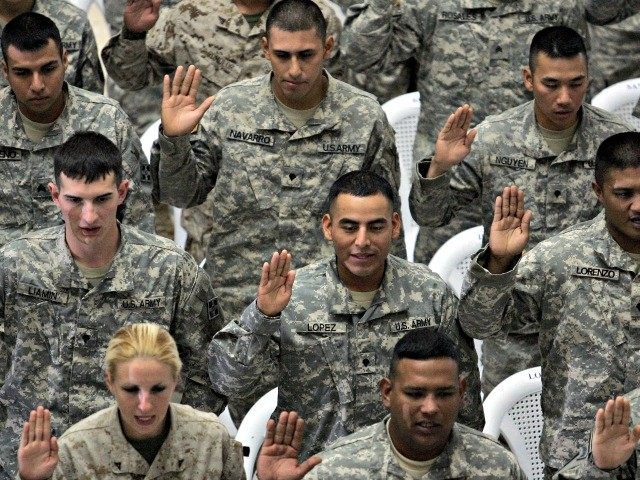The U.S. Army, in a sign of military escalation, even as President Obama tries to draw down America’s military footprint, is deploying a battalion of 500 infantrymen to volatile Helmand province, a Taliban stronghold.
This development comes a week after outgoing top American commander of U.S. and NATO forces in Afghanistan, Gen. John Campbell, told lawmakers that President Obama has ordered the U.S. forces to only strike the Taliban in self-defense.
“To attack the Taliban just because they’re Taliban, I do not have that authority,” declared Campbell. “Our country has made the decision that we are not at war with the Taliban,” he added.
The Guardian first reported that the Army battalion would be sent to Helmand. Fox News elaborated further. “By month’s end, a force described as battalion-strength, consisting of mostly army soldiers, will arrive in Helmand province where US and UK forces have struggled in battles for over a decade to drive out the Taliban,” reported The Guardian. “The infantry battalion will relive a smaller one currently in Helmand.”
The 500 soldiers are being sent to relieve a company of 150 troops, providing the U.S. Army a force of an estimated 350 additional service members to prevent the resilient Taliban from conquering volatile Helmand province, added Fox News.
Defense officials familiar with the move reportedly indicated that “the Army’s 2-87 infantry battalion, part of the 10th Mountain Division based at Ft. Drum, N.Y., was scheduled to deploy to Bagram Airbase in Afghanistan this winter–but instead will be sent to Helmand.”
Gen. Campbell also indicated that “the additional soldiers will provide increased ‘force protection’ for a team of special operations forces training and advising the Afghan Army’s 215th Corps, which has suffered from desertions and poor leadership.”
Defense officials acknowledged that the number of U.S. soldiers in Afghanistan will remain at 9,800 even when accounting for new deployment of 500 troops.
Despite the constantly cited estimate of 9,800 American service members serving in Afghanistan, the most recent Special Inspector General for Afghanistan Reconstruction (SIGAR) quarterly report to Congress places that figure at 8,950 as of the end of 2015, signaling a drawdown from the beginning of last year.
“Our mission remains the same,” Col. Michael Lawhorn, a spokesman for the U.S. command in Kabul, told The Guardian, “to train, advise, and assist [TAA] our Afghan counterparts, and not to participate in combat operations.”
President Obama declared an end to the U.S. combat mission in Afghanistan at the end of 2014, marking the beginning of the TAA American military on January 1, 2015.
Since President Obama declared an end to the combat mission on December 31, 2014, security conditions have deteriorated, the Taliban’s reach in Afghanistan is greater than at any point since 2001, and the capabilities of Afghan National Defense and Security Forces (ANDSF) have been deemed less than desirable, SIGAR told lawmakers.
Although some American troops have been killed during combat operations, including one in Helmand last month, the Pentagon has hesitated to say U.S. forces are engaged in combat.
Pentagon press secretary Peter Cook said, U.S. troops had participated in “combat situation[s], but are not in the lead intentionally,” a testament to how the difference between combat and the TAA mission can blur in practice.
SIGAR also told Congress that the U.S. military in Afghanistan has been drawn into combat against the Taliban even after Obama said American troops had ceased their combat mission in the country.
The Taliban has made a comeback in Helmand province, one of the deadliest regions for U.S.-led international forces since the war started in October 2001.
Prior to the end of the combat mission and the drawdown in 2014, 378 U.S. Marines and 450 British soldiers reportedly died in Helmand, which is located along the Pakistan border, next to Kandahar province, the birthplace of the Taliban.
According to a December 2015 assessment by The Long War Journal, the Taliban controls (5) or heavily contests (5) ten of Helmand’s thirteen provinces.
“The south, most particularly in Helmand, remains contested, but we expected that,” U.S. Brig. Gen. Wilson Shoffner, a top spokesman in Afghanistan, told reporters last month. “We expected for the Taliban to hold on to what has been traditionally the heart of their support base.”
Helmand is a rich source of revenue for the Taliban from the province’s poppy plants. U.S. Army Staff Sgt. Matthew Q. McClintock was killed and two other soldiers wounded in a Helmand operation last month.
“Campbell told Congress that a quarter of Afghanistan is now in danger of falling to the Taliban. But he told lawmakers last week he did not want to make any public announcements about troop levels,” reports Fox News.
President Obama’s current plan is to reduce the U.S. military footprint to 5,500 by the end of 2016.

COMMENTS
Please let us know if you're having issues with commenting.